OTHER SPECIAL DAYS.
| MONTH No. | | REFERENCE | |
| Fourth | Breach of Jerusalem Walls | Jeremiah 39, 2 | |
| Fifth | Destruction of the Temple | Jeremiah 52, 12 | |
| Seventh | Death of G'daliah | Jeremiah 41, 2 | |
| Tenth | Siege of Jerusalem began | 2 Kings 25, 10 | |
| POST BIBLICAL | |||
| First | Fast of the Firstborn | S. A. Orach Chayim 470, 1 | |
| 12th or 13th. | Fast of Esther, | Esther 4, 16 |
(See also DIAGRAM OF JEWISH YEAR. )
TISH'A B'AV.
 Tish'a B'Av (9th of Av) is a day of mourning observed in remembrance for the destruction of the first and second Temples. In all probability neither Temple was destroyed on that day; but the two calamities were very close to this date. In the second book of Kings we are told In the fifth month, on the seventh day of the month � came Nebuzaradan, captain of the guard, a servant of the king of Babylon, to Jerusalem; and he burned the house of the Lord,2. while in Jeremiah we read: Now in the fifth month, in the tenth day of the month, which was the nineteenth year of Nebuchadrezzar king of Babylon, came Nebuzaradan, captain of the guard, who served the king of Babylon, to Jerusalem, and burned the house of the Lord,3. Some eight centuries later, Talmudic Rabbis 4. tried to answer this contradiction by saying that the Babylonians entered the outer areas of the Temple on 7th set light to it on the 9th and it burned until the 10th. However this does seem a little contrived.
Tish'a B'Av (9th of Av) is a day of mourning observed in remembrance for the destruction of the first and second Temples. In all probability neither Temple was destroyed on that day; but the two calamities were very close to this date. In the second book of Kings we are told In the fifth month, on the seventh day of the month � came Nebuzaradan, captain of the guard, a servant of the king of Babylon, to Jerusalem; and he burned the house of the Lord,2. while in Jeremiah we read: Now in the fifth month, in the tenth day of the month, which was the nineteenth year of Nebuchadrezzar king of Babylon, came Nebuzaradan, captain of the guard, who served the king of Babylon, to Jerusalem, and burned the house of the Lord,3. Some eight centuries later, Talmudic Rabbis 4. tried to answer this contradiction by saying that the Babylonians entered the outer areas of the Temple on 7th set light to it on the 9th and it burned until the 10th. However this does seem a little contrived.
There is a contemporary account of the end of the Second Temple. Josephus, who witnessed the event, describes how a fire was started during the Roman assault in 70 CE which totally destroyed it. He says that the Romans attacked it on the 10th day of the month of Lous (Av) (on which it was finally destroyed by the King of Babylon.)5.
(2.) 2 Kings 25, 8-9. (3.) Jeremiah 52, 12-13. (4.) Ta'anit 29a. (5.) Wars 6, 4, #5.
EARLY DEVELOMENT OF THE DAY.
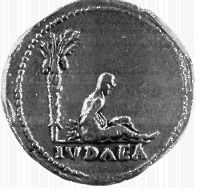 |
as a bound captive. |
It appears from the quotation above that in Josephus', time the 10th was the day associated with the destructions. However less than 150 years later the Mishnah states that these took place on the 9th Av.6. It also mentioned that on this date other tragedies occurred.
It is not clear whether the date of mourning changed because of the two events of the second century, or whether it was due to the influence of an earlier seven-day festival from the 9th to the 15th of Av as Schauss suggests.8. Whatever the reason, at least from the third century onward the day was observed on the 9th except when that was a Saturday, in which case it was observed on the 10th.
(6.) Ta'anit 4, 6. (7.) Num. 14, 29ff. (8.) The Jewish Festivals pp. 297-8.
LATER SIGNIFICANCE.
The day developed a reputation for being a day of calamities and people looked for other tragedies that had occurred on that date. Apart from the three listed above, various other events are said to have happened on it:
The association of some of these dates could be fanciful or forced. When dealing with expulsions various dates could be regarded as significant.
- The day someone proposed the expulsion.
- The days when discussions took place.
- The day it was finally decided to expel them.
- The day the decree was published and the Jews notified.
- The date by which all Jews must have left.
For the English Jews, it was the third of these.10. While for Spain we learn that the last Jew left Spain on the 7th Av.11. Although claimed in several sources,12. the outbreak of the first world war did not begin on Tisha B'Av. War was declared on August 4th, 1914 which was 12th Av. The act which sparked off the war was the assassination in Sarajevo on June 28th, 1914 and that was not even in the month of Av.
Mediaeval Jewish history is filled with persecutions of one kind or another. Accusations of murdering Christian children, desecrating the church wafer, poisoning the wells were followed by attacks by Crusaders, Cossacks and anti-Semitic mobs in various countries. Jews were expelled from towns and countries all over Europe, and tortured and burnt at the stake by the Inquisition. These did not just take place on the 9th of Av, but all through the year. The webmaster has included a number of these on the TITLE PAGE of this web site as events that happened On This Day. There were so many that he deliberately omitted many in favour of happier or more modern events. Because of all this, many Jews observe Tisha B'Av to remember the whole range of Jewish sufferings throughout the ages.
See also EARLY DEVELOMENT OF TISH'A B'AV.
(9.) EJ vol 3, col. 936. (10.) C. Roth, History of The Jews of England, p. 85. (11.) EJ vol 15, col. 241. (12.) Schauss, The Jewish Festivals pp. 97-98 and Klein, A Guide to Jewish Religious Practice p. 247.
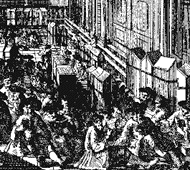 |
Germany, 1748. |
TISH'A B'AV OBSERVANCES.
Tish'a B'Av is a full day fast, and because of the mourning it is sometimes known as "the Black Fast" as opposed to Yom Kippur, "the White Fast".Various mourning customs are practised. The congregation often sit on low stools or even on the floor. Some even used to sleep on the floor during that night. The book of Lamentations is read on that day. This book contains poems of lament for the loss of the first Temple. These are traditionally attributed to Jeremiah, but were probably written later. Various matters which were considered as luxuries to the body were set aside for the day. Food, bathing, anointing oneself and the wearing of leather shoes were forbidden.13. The laws concerning the fast became more and more restrictive between the fifteenth and eighteenth century.14.
(13.)Ta'anit 1, 5; S A Orach Chayim 554, 1. (14.) For details, see JE, vol 1, pp. 23-4.
SEVENTEENTH OF TAMMUZ.
 Ta'anit Sh'va 'Asar B'Tammuz (Fast of 17th Tammuz) began with the events leading up to the fall of the first Temple in 586 BCE as described by Jeremiah when he said: In the eleventh year of Zedekiah, in the fourth month, the ninth day of the month, a breach was made in the city (walls).15. Zechariah's Fast of the Fourth Month must originally have been kept on the 9th Tammuz. However in the case of the second Temple, Josephus said that on the 17th Tammuz Titus gave orders to make a way through the walls at the Antonia Tower. He also said that it was on this day that the daily sacrifice in the Temple ceased.16. This date was reaffirmed by the Mishnah.17. So the present date of the fast clearly dates from after 70 CE. The Mishnah states that other events that occurred on that day were:
Ta'anit Sh'va 'Asar B'Tammuz (Fast of 17th Tammuz) began with the events leading up to the fall of the first Temple in 586 BCE as described by Jeremiah when he said: In the eleventh year of Zedekiah, in the fourth month, the ninth day of the month, a breach was made in the city (walls).15. Zechariah's Fast of the Fourth Month must originally have been kept on the 9th Tammuz. However in the case of the second Temple, Josephus said that on the 17th Tammuz Titus gave orders to make a way through the walls at the Antonia Tower. He also said that it was on this day that the daily sacrifice in the Temple ceased.16. This date was reaffirmed by the Mishnah.17. So the present date of the fast clearly dates from after 70 CE. The Mishnah states that other events that occurred on that day were:
(15.) Jeremiah 39, 2. (16.) War 6, 2, #1. (17.) Ta'anit 4, 6. (18.) Yoma 4b. and Ta'anit 28b.
TENTH OF TEVET.
 Ta'anit Asarah B'Tevet (The Fast of 10th Tevet) is based upon the verse which described the attack on Jerusalem in 586 BCE : In the tenth month, in the tenth day of the month, Nebuchadnezzar king of Babylon came, he, and all his army, against Jerusalem, and camped against it; and they built a siege wall around against it.19.
The fast is mentioned in the Talmud 20. but less attention is paid to it than to 17th Tammuz.
Ta'anit Asarah B'Tevet (The Fast of 10th Tevet) is based upon the verse which described the attack on Jerusalem in 586 BCE : In the tenth month, in the tenth day of the month, Nebuchadnezzar king of Babylon came, he, and all his army, against Jerusalem, and camped against it; and they built a siege wall around against it.19.
The fast is mentioned in the Talmud 20. but less attention is paid to it than to 17th Tammuz.
(19.) 2 Kings 25, 1. (20.) Rosh Hashanah 18b.
PRACTICES OF MINOR FASTS.
Both 10th of Tevet and 17th Tammuz last only from sunrise to sunset and are not for the full day like Tish'a B'Av. As a result they are not so widely observed, and the law is less stringent concerning them. Work is not forbidden on these days and leather shoes may be worn.
THE THREE WEEKS.
The Fast of Tammuz is relatively more important than the Fast of Tevet because it is linked with Tish'a B'Av. The three weeks between the latter are regarded as days of mourning. No joyous events 21. or weddings take place in Orthodox congregations. Many of the more Orthodox Jews do not shave in this period. From the 1st of Av such people do not eat meat.22. Synagogue services reflect the mood of the period with different prayers added and often with altered music.
(21.) S A Orach Chayim 551, 2. (22.) S A Orach Chayim 551, 9.
THE TEMPLE FASTS.
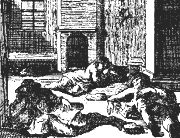 |
of Av 9th, Germany, 1748. |
The mourning during the three weeks and on Tish'a B'Av was originally a way to express the sadness of Jews because they were no longer able to offer sacrifices in the Temple. For the Jews of the 1st century CE, the Temple sacrifices were essential for the practice of Judaism. Without the sacrifices they feared that God would not listen to their prayers nor would He forgive their sins. Their sense of loss for the Temple was as strong as the feeling of loss at the death of a loved one and hence the practices of mourning. Fasting was part of the self-punishment, and was similar to tearing garments and the sitting on low uncomfortable chairs.
Today, few Jews see the sacrifice of animals as being the right way to achieve forgiveness or even of having our prayers heard. Only a small number of extremists really want to offer animal sacrifices again. As a result many Reform and Liberal Jews do not feel the need to mourn for the loss of the Temple. That loss proved to be a turning point in our history.
As a result, where Tisha B'Av is observed in Reform or Liberal congregations the emphasis has been placed on mourning for the deaths and sufferings of so many Jews throughout our history. Certainly they mourn for the deaths involved the attacks on Jerusalem and the sacking of the city on two occasions; but they can not feel sad that the Temple no longer exists or that vast numbers of animals were saved from unnecessary slaughter by these historical events.
HAPPIER DAYS
TU BISHVAT.

 Tu Bishvat, 15th of the Hebrew month of Sh'vat, is also called the New Year for Trees. (TU in the name are the Hebrew letters equivalent to 9 and 6 which add up to 15. We do not use 10 + 6 as these would spell the Divine Name.) It is now sometimes observed as a minor festival, on which penitential days are said. It was the equivalent of the beginning of our tax year. When collecting their tithes (10% of their harvest) of fruit to be offered up in each year, the calculation was made from Sh,vat to Sh'vat.23. This was thought to be the date when the sap began to rise in trees or as the Talmud says the greater part of the year's rain has fallen.24. The 15th of the month was full moon and probably had agricultural significance as the beginning of the grape harvest. Centuries later this previous agricultural festival was observed by eating fifteen types of fruit.
Tu Bishvat, 15th of the Hebrew month of Sh'vat, is also called the New Year for Trees. (TU in the name are the Hebrew letters equivalent to 9 and 6 which add up to 15. We do not use 10 + 6 as these would spell the Divine Name.) It is now sometimes observed as a minor festival, on which penitential days are said. It was the equivalent of the beginning of our tax year. When collecting their tithes (10% of their harvest) of fruit to be offered up in each year, the calculation was made from Sh,vat to Sh'vat.23. This was thought to be the date when the sap began to rise in trees or as the Talmud says the greater part of the year's rain has fallen.24. The 15th of the month was full moon and probably had agricultural significance as the beginning of the grape harvest. Centuries later this previous agricultural festival was observed by eating fifteen types of fruit.
Tu Bishvat received a new lease of life in the twentieth century, when the Zionists made an effort to replant the Judean hills with trees after centuries of neglect under Turkish rule. In the Yeshuv Tu Bishvat became the day when children were encouraged to plant young trees. While Jews outside the land collected money for tree-planting.
(23.) Rosh Hashanah 1, 1. (24.) R. H. 14a.
CHAMISHAH ASAR B'AV.
 Chamishah Asar B'Av, 15th Av, falls exactly half a year away from Tu Bishvat in normal years(not leap years) and was observed as a minor festival. Its original purpose was forgotten and Talmudic Rabbis suggested six possible reasons for it.25. One of these was that during Temple times it was the last day that wood could be collected for burning on the altar. Hence it was sometimes described as the New Year for Sacrifices.
(See Diagram Of Jewish Year. ) It was described as a day of rejoicing: There were no happier days for Israel than the 15th Av and the Day of Atonement, for on them the daughters of Jerusalem went out in white garments � to dance in the vinyards.26. These days marked the beginning and the end of the grape harvest. The only way that the day is now observed is that penitential prayers (Tahanun) are not said in the daily service and eulogies are not delivered at funerals.
Chamishah Asar B'Av, 15th Av, falls exactly half a year away from Tu Bishvat in normal years(not leap years) and was observed as a minor festival. Its original purpose was forgotten and Talmudic Rabbis suggested six possible reasons for it.25. One of these was that during Temple times it was the last day that wood could be collected for burning on the altar. Hence it was sometimes described as the New Year for Sacrifices.
(See Diagram Of Jewish Year. ) It was described as a day of rejoicing: There were no happier days for Israel than the 15th Av and the Day of Atonement, for on them the daughters of Jerusalem went out in white garments � to dance in the vinyards.26. These days marked the beginning and the end of the grape harvest. The only way that the day is now observed is that penitential prayers (Tahanun) are not said in the daily service and eulogies are not delivered at funerals.
(25.) Baba Batra 121 a & b. (26.) Ta'anit 4, 8.
YOM HA-ATSMA'UT.
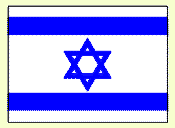
 Yom Ha-Atsma'ut, Israel Independence Day, ic celebrated both as a religious and a secular day of rejoicing and thanksgiving on 5th Iyar. If the 5th falls on a Friday or the Sabbath, then the day is brought forward to the Thursday. On May 14th, 1948, David Ben Gurion, the prime minister, declared that the country was now an independent state, following the decision of the United Nations to partition Palestine. In Israel itself, the day before is devoted to remembrance of those who died in the War of Independence and other war dead, while the actual day is one of national celebration. Outside of Israel some congregations hold special services of thanksgiving, while others hold secular celebrations which often include Israeli music and dancing, and the eating of Israeli food, etc. It was suggested that the Hallel (Psalms 113 - 118) should be recited on the day as it is on other festivals marking deliverance and thanksgiving, but this is not the current practice.
Yom Ha-Atsma'ut, Israel Independence Day, ic celebrated both as a religious and a secular day of rejoicing and thanksgiving on 5th Iyar. If the 5th falls on a Friday or the Sabbath, then the day is brought forward to the Thursday. On May 14th, 1948, David Ben Gurion, the prime minister, declared that the country was now an independent state, following the decision of the United Nations to partition Palestine. In Israel itself, the day before is devoted to remembrance of those who died in the War of Independence and other war dead, while the actual day is one of national celebration. Outside of Israel some congregations hold special services of thanksgiving, while others hold secular celebrations which often include Israeli music and dancing, and the eating of Israeli food, etc. It was suggested that the Hallel (Psalms 113 - 118) should be recited on the day as it is on other festivals marking deliverance and thanksgiving, but this is not the current practice.
LAG BA-OMER.
 Lag Ba-Omer, the 33rd day of the Omer is a very minor festival. (The value of the Hebrew letters
Lag Ba-Omer, the 33rd day of the Omer is a very minor festival. (The value of the Hebrew letters  Lag are 30 + 3 = 33.) In temple times, from the second day of Passover they would bring an omer, a sheaf or measure of corn, counting off 49 days. Then the 50th was observed as Shavuot. Lag Ba-Omer falls on 18th of Iyar.
(See Diagram Of Jewish Year. )
Lag are 30 + 3 = 33.) In temple times, from the second day of Passover they would bring an omer, a sheaf or measure of corn, counting off 49 days. Then the 50th was observed as Shavuot. Lag Ba-Omer falls on 18th of Iyar.
(See Diagram Of Jewish Year. )
During the S'firah, the counting of the omer, weddings27., dancing and the playing of instrumental music are forbidden by Orthodox Judaism.28. It is therefore a period of sadness and mourning when the hair is not cut.29. The exact period of these restrictions vary from community to community.30. However, during Passover, on Rosh Chodesh (First of the month) of Iyar and Sivan, on 33rd day of the Omer and more recently on Israel Independence Day, these rules are set aside and celebrations can take place.
(27.) S. A. Orach Chayim 493, 1. (28.) Ganzfried K.S.A. 3, 120, #9. (29.) S.A. Orach Chayim 493, 2. (30.) Isserles, S.A. Orach Chayim 493, 3 & Ganzfried K.S.A. 3, 120, #6.
REASONS FOR LAG BA-OMER.
The origins of and reasons for these practices are far from certain. The usual reason given for observing Lag Ba-Omer is that there was a plague among the pupils of Rabbi Akiva and that 24,000 31. or 12,00032. of them died, and it was on the 33rd day of the Omer counting that the plague stopped.33. The Talmud only mentions the deaths of the students and not when the deaths stopped, so there is no link to Lag Ba-Omer. Centuries later, we find this mentioned in the Shulchan Aruch.34. Other explanations for the solemnity or mourning at this period are:
- The Rabbi Akiva's students died fighting in the revolt of Bar Kochba. And on 33rd there was a Jewish victory.
- During this time it was being decided whether fruit trees were to be blessed with a good crop causing this to be a serious period.35.
- In memory of the occasions when the Crusaders attacked Jewish communities on the way to the Holy Land about this season.
- The Romans regarded certain months and days as unlucky. Because of this there were some days when no business was done. Marriages involved financial contracts, and it would have been thought unwise to arrange one on an unlucky day. Some Lag Ba-Omer customs may therefore have been chukat ha-goy (non-Jewish in origin).
(31.) Yevamot 62b. (32.) Gen. Rabba 61, 3 & Eccles. Rabba 11, 6. (33.) S.A. Orach Chayim 493, 1 & 2. (34.) Ibid. (35.) Rosh Hashanah 16a.
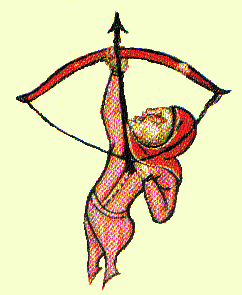 |
Spain, 1350 CE. |
HISTORY OF LAG BA-OMER.
After it was linked with Rabbi Akiva's students, it became known as the scholars festival. In about the 16th century, Kabalists (Jewish mystics) tried to make the day more important by saying that the day was the anniversary of the death of Shimon bar Yohai, who they mistakenly thought was the author of the Zohar ( a mystic work written by Moses de Leon in the 13th cent. CE.) On Lag Ba-Omer mystics still gather at the tomb of Shimon bar Yohai at Merom in northern Israel. On this day they often give their children their first haircut. Other practices which are even more difficult to explain are the lighting of bonfires and children playing with bows and arrows. The day probably goes back to pre-Jewish folk customs and some of the present practices may reflect little more than superstitions. For most mainstream Jews, Lag Ba-Omer is only observed as a day when weddings can be performed and when Tahanun is not said.
| FOR FULL ALPHABETICAL INDEX OF CUSTOMS |